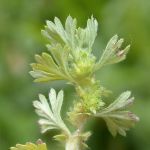| Common Name: |
Breakstone Parsley |
| Other Names: |
Parsley Piert |
| Botanical Name: |
Aphanes arvensis |
| Genus: |
Aphanes |
| Family: |
Rosaceae |
| Native Location: |
Europe, N Africa, N America |
| Cultivation: |
Well-drained soil in sun or partial shade. Athanes arvensis tolerates gravelly or stony soils, and acidic and alkaline conditions. |
| Propagation: |
By seed sown in spring. Plants usually self-sow. |
| Harvest: |
Plants are cut when flowering in early summer and used fresh, or dried for infusions, liquid extracts, and tinctures. May also be frozen. |
| Height: |
2.5cm (1in) |
| Width: |
20cm (8in) |
| Hardiness: |
Hardy |
| Parts Used: |
Whole plant |
| Properties: |
An astringent herb that has diuretic effects, and soothes irritated or inflamed tissues. |
| Medicinal Uses: |
Internally for kidney and bladder stones, and chronic kidney and liver disorders. Often combined with Agathosma spp. (see oval-leaf buchu) for kidney and bladder complaints and with Althea officinalis (see marshmallow) to increase demulcent effect for kidney stones. |
| Bibliography: |
Encyclopedia of Herbs by Deni Brown Copyright © 1995, 2001 Dorling Kindersley Limited Pp 124-125 |

